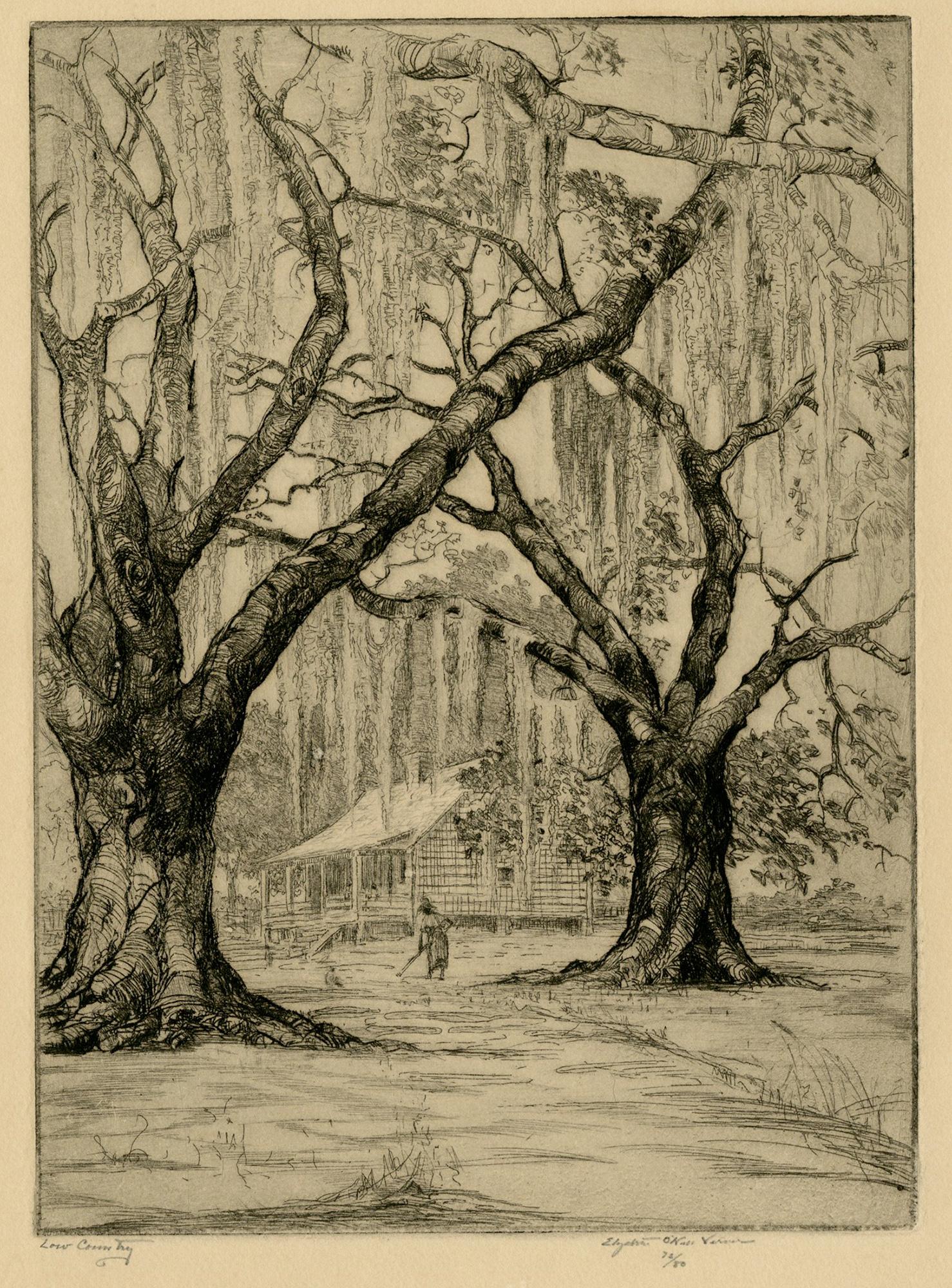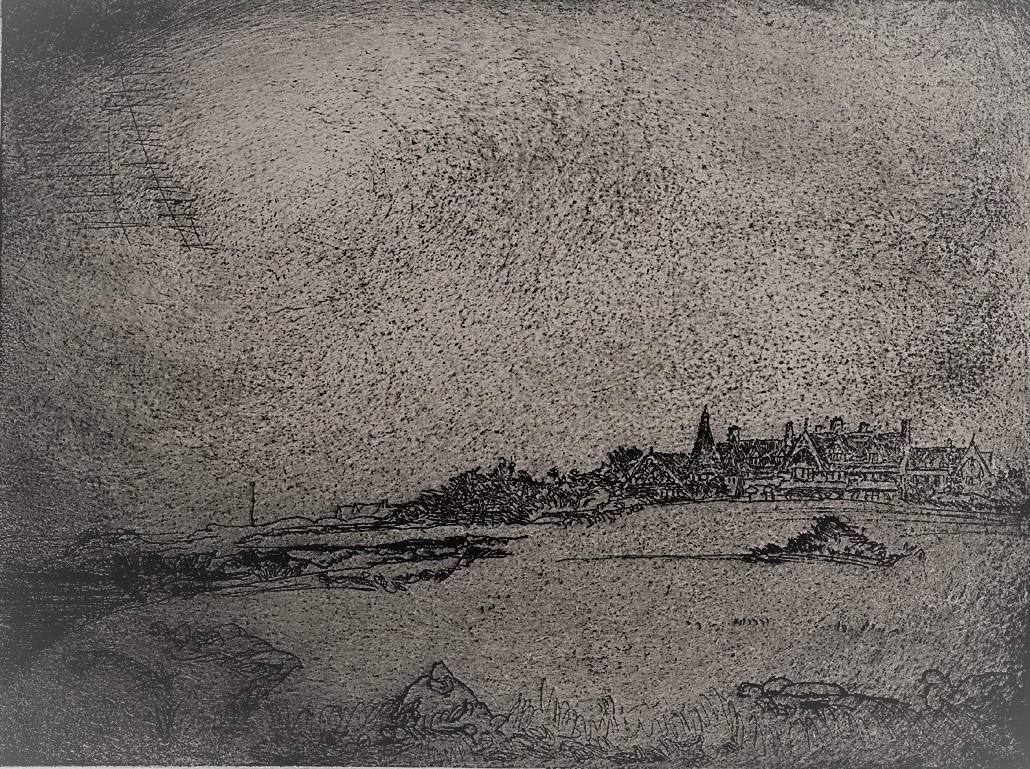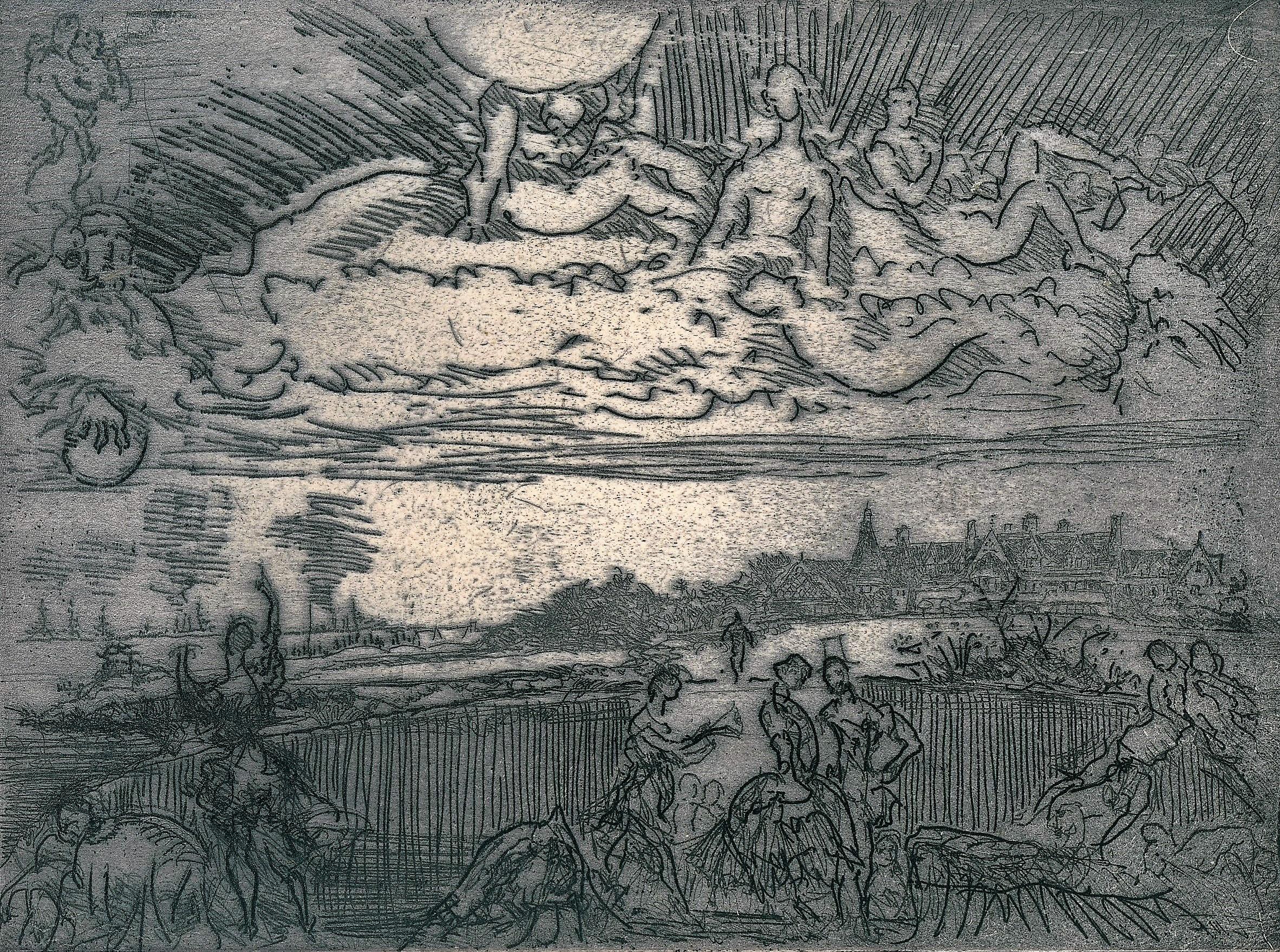Martin LewisThe Passing Freight, Danbury1934
1934
About the Item
- Creator:Martin Lewis (1881-1962, American, Australian)
- Creation Year:1934
- Dimensions:Height: 18 in (45.72 cm)Width: 233.5 in (593.09 cm)
- Medium:
- Movement & Style:
- Period:
- Condition:
- Gallery Location:Storrs, CT
- Reference Number:1stDibs: LU33529570792
Martin Lewis
Martin Lewis was born in Castlemaine, Victoria, Australia, on June 7th, 1881. He was the second of eight children and had a passion for drawing.
At the age of 15, Lewis left home and traveled in New South Wales, Australia, and in New Zealand, working as a pothole digger and a merchant seaman. He returned to Sydney and settled into a Bohemian community outside Sydney. Two of his drawings were published in the radical Sydney newspaper, The Bulletin. He studied with Julian Ashton at the Art Society's School in Sydney. Ashton was an English-born Australian artist and teacher known for his support of the Heidelberg School and for his influential art school in Sydney.
In 1900, Lewis left Australia for the United States. His first job was in San Francisco, painting stage decorations for William McKinley's presidential campaign of 1900. By 1909, Lewis was living in New York, where he found work in commercial illustration. His earliest known etching is dated 1915. However, the level of skill in this piece suggests he had been working in the medium for some time previously. It was during this period that he helped Edward Hopper learn the basics of etching.
In 1920, after the breakup of a romance, Lewis traveled to Japan, where for two years he drew and painted and studied Japanese art. The influence of Japanese prints is very evident in Lewis's prints after that period. In 1925, he returned to etching and produced most of his well-known works between 1925 and 1935. Lewis's first solo exhibition in 1929 was successful enough for him to give up commercial work and concentrate entirely on printmaking.
Lewis is most famous for his black and white prints, mostly of night scenes of non-tourist, real-life street scenes of New York City. During the Depression, however, he was forced to leave the city for four years between 1932 and 1936 and move to Newtown, Connecticut. His work from this period includes a number of rural, night-time, and winter landscape scenes in this area.
Lewis returned to Manhattan in 1936 and continued to etch and paint. He taught printmaking at the Art Students League of New York from 1944 until his retirement in 1952. Now he is considered one of the most important American printmakers of the twentieth century.
Find original Martin Lewis prints and other art on 1stDibs.
(Biography provided by Allinson Gallery, Inc.)
- ShippingRetrieving quote...Ships From: Storrs, CT
- Return PolicyA return for this item may be initiated within 3 days of delivery.
- House on Cliff Walk, Newport, Rhode IslandBy Clifford Isaac AddamsLocated in Storrs, CTHouse on Cliff Walk, Newport, R.I. 1931-1932. Etching and drypoint. Hausberg catalog 13 state .i/ii. Edition 75 in this state. 5 7/8 x 7 7/8 (sheet 9 x 13 1/2). A rich impression pr...Category
Mid-20th Century American Modern Landscape Prints
MaterialsDrypoint, Etching
- Caprice, or House on Cliff Walk, Newport, Rhode IslandBy Clifford Isaac AddamsLocated in Storrs, CTHouse on Cliff Walk, Newport, Rhode Island or Caprice, Newport, Rhode Island.. 1931/33. Etching. Hausberg catalog 138 state ii. 5 15/16 x 8 (sheet 7 7/8 x 9 5/8). A rich impression ...Category
Mid-20th Century American Modern Landscape Prints
MaterialsDrypoint, Etching
- Bailey's Beach, Newport, Rhode Island.By Clifford Isaac AddamsLocated in Storrs, CTBailey's Beach (Newport, Rhode Island). c. 1931-1933. Etching and drypoint. Hausberg catalog 126 state vi. Edition 75. 6 x 7 7/8 (sheet 9 9/16 x 12 1/2). Printed on cream wove paper ...Category
Mid-20th Century American Modern Landscape Prints
MaterialsDrypoint, Etching
- Bailey's Beach, Newport, Rhode Island.By Clifford Isaac AddamsLocated in Storrs, CTBailey's Beach (Newport, Rhode Island). 1933. Etching. Hausberg 126 state v/vi. Edition 75. 6 x 7 7/8 (sheet 9 3/8 x 12 3/8). Printed with extensive plate tone with plate tone on 'Va...Category
Mid-20th Century American Modern Landscape Prints
MaterialsDrypoint, Etching
- Quarter of Nine, Saturday's Children.By Martin LewisLocated in Storrs, CTQuarter of Nine, Saturday's Children. 1929. Drypoint. McCarron 78. 9 3/4 x 12 3/4 (sheet 12 7/8 x 17 7/8). Illustrated: American Etchers: Martin Lewis. Edition 107. A fine impression...Category
1920s American Modern Figurative Prints
MaterialsDrypoint, Etching
- The Gothic SpiritBy John Taylor ArmsLocated in Storrs, CTThe Gothic Spirit (also called A Gargoyle, A Gothic Spirit). 1922. Etching and stipple. Fletcher 120. 11 5/8 x 7 (sheet 15 1/4 x 11 1/4). Gargoyle Series #8. Edition 130. Illustrated...Category
1920s American Modern Landscape Prints
MaterialsDrypoint, Etching
- Irving Guyer, Christmas Trees on Second Street (NYC)By Irving GuyerLocated in New York, NYPhiladelphia-born Irving Guyer attended the Art Students League and worked in New York City before moving to California. This print is signed and titled i...Category
1930s American Modern Figurative Prints
MaterialsEtching, Drypoint
- Low Country (South Carolina)By Elizabeth VernerLocated in Middletown, NYAn enchanting Southern landscape by the mother of the Charleston Renaissance. A native of Charleston, South Carolina, and educated under the tutelage of Thomas Anshutz at The Pennsylvania Academy of Fine Arts, O'Neill Verner was a teacher, a mother, an artist, an ardent preservationist, and a skilled autodidact. Having previously focused on painting, in the early 1920s she found herself deeply moved by printmaking as a media, and especially so by the simple, peaceful themes and tableaus she discovered in Japanese art. She embarked on a effort to teach herself Japanese printmaking techniques, and in the process, produced the charming images of every day life in Charleston and its environs that earned her recognition as a cultural icon in her day, and in more modern times, as the mother of the Charleston Renaissance, which flourished well into the 1930s. In 1923 she opened a studio in Charleston where she focused on documenting the local color and the architecture and landscape that distinguishes Charleston as one of the South's most beautiful cities, all the while applying the gentle and poetic thematic sensibilities of Japanese printmaking. O'Neill Verner soon found herself in high demand when municipalities and institutions throughout the country sought commissions from her to document the beauty of their grounds and historic buildings. She worked as far north as the campuses of Harvard and Princeton, and extensively across the South, including in Savannah, Georgia, where through sweeping commissions she was able to marry her love of southern preservation and art. O'Neill Verner was a lifelong learner, and continued a path of edification that led her to study etching at the Central School of Art in London, to travel extensively through Europe, and to visit Japan in 1937, where she studied sumi (brush and ink) painting. She was a founding member of the Charleston Etchers Club, and the Southern States Art League. Her works are represented in the permanent collections of leading museums across the American south, and in major national institutions including the Metropolitan Museum of Art, Boston's Museum of Fine Art, and the Smithsonian American Art Museum. O'Neil Verner...Category
Early 20th Century American Modern Landscape Prints
MaterialsArchival Paper, Drypoint, Etching
- Comanche Dance, Ildefonso Pueblo, New Mexico Southwest Framed EtchingBy Gene KlossLocated in Denver, COComanche Dance at San Ildefonso Pueblo (New Mexico). Etching and drypoint, artist's proof from an edition of 50 prints. Presented in a custom frame, outer dimensions measure 22 ¼ x 18 ½ x ½ inches. Image size is 11 ¾ x 14 ½ inches. Print is clean and in very good vintage condition - please contact us for a detailed condition report. Expedited and international shipping is available - please contact us for a quote. About the Artist: Gene (Alice Geneva) Kloss is considered one of America’s master printmakers. She was born in Oakland, California and established herself as an artist on the West coast. Kloss was introduced to etching by Perham Nahl while at UC Berkley. She graduated in 1924, and in 1925 married poet Phillips Kloss. In her late twenties, Kloss moved to Taos, New Mexico and began her life’s work of the New Mexican landscape and peoples. It was at this time that she received national acclaim. Her artwork exudes an unmistakable content and style. Enchanted by the architecture, mountainous landscapes and rituals of the inhabitants, Kloss captured the beauty of the Southwest and surrounding areas. Her style was bold yet deftly simple, masterfully expressing the elusive Southwestern light...Category
1980s American Modern Figurative Prints
MaterialsDrypoint, Etching
- Guardians of the Spire; Amiens Cathedral Number 2By John Taylor ArmsLocated in Middletown, NYGuardians of the Spire; Amiens Cathedral Number 2 New York: 1937. Etching and drypoint on watermarked F.J. Head cream-colored, antique laid paper, 6 3/4 ...Category
Mid-20th Century American Modern Figurative Prints
MaterialsEtching, Drypoint
- Palazzo dell'AngeloBy John Taylor ArmsLocated in Middletown, NYPalazzo dell'Angelo 1931 Etching and drypoint on cream-colored, handmade laid paper with deckle edges, 7 1/4 x 6 3/4 inches (185 x 171 mm), edition of 100, full margins. Signed, dated and numbered "Ed. 100" in pencil, lower margin, second state (of three). Printed by Henry Carling, New York. Extremely minor mat tone and some inky residue in the top right corner, all unobtrusive and well outside of image area. An exquisite impression of this intricate image, with astonishing detail, and all the fine lines printing clearly. The image represents the first print which Arms printed on his own handmade paper. Framed handsomely with archival materials and museum grade glass in a wood gilt frame with a flower and garland motif. Illustrated: Dorothy Noyes Arms, Hill Towns and Cities of Northern Italy, p. 180; Anderson, American Etchers Abroad 1880-1930; Eric Denker, Reflections & Undercurrents: Ernest Roth and Printmaking in Venice, 1900-1940, p. 116. [Fletcher 233] Born in 1887 in Washington DC, John Taylor Arms studied at Princeton University, and ultimately earned a degree in architecture at the Massachusetts Institute of Technology in 1912. With the outbreak of W.W.I, Arms served as an officer in the United States Navy, and it was during this time that he turned his focus to printmaking, having published his first etching in 1919. His first subjects were the Brooklyn Bridge, near the Navy Yard, and it was during his wartime travel that Arms created a series of extraordinarily detailed etchings based on Gothic cathedrals and churches he visited in France and Italy. He used what was available to him, namely sewing needles and a magnifying glass, to create the incredibly rich and fine detail that his etchings are known for. Upon his return to New York after the war, Arms enjoyed a successful career as a graphic artist, created a series of etchings of American cities, and published Handbook of Print Making and Print Makers (Macmillan, 1934). He served as President of the Society of American Graphic Artists, and in 1933, was made a full member of the National Academy of Design. In its most modern incarnation, Palazzo dell'Angelo was constructed in or around 1570. The building, which has a rich and storied history, was erected upon the ruins of an earlier structure which predates the Gothic period. Some remnants of the earliest features of the residence were most certainly still visible when Arms visited, as they are today. Having a background in architecture, there's no question that Arms was moved by the beauty, history and ingenuity represented in the physical structure. One thing specifically gives away Arms's passion for the architecture, and that is the fact that he focused on the building's Moorish entranceway, balustrade, and two mullioned windows, and not on the curious Gothic era bas-relief of an angel nestled into the facade of the building, after which the structure is named. The sculpture itself doesn't appear in Arms's composition at all, despite the fact that it is the feature of the building that is most famous in its folklore. Arms instead focuses on the oldest portion of the architecture, even documenting some of the remnants of a fresco, and a funerary stele for the freedman Tito Mestrio Logismo, and his wife Mestria Sperata (visible above the water level, to the left of the door, behind the gondola), which was first described in 1436. Among the many notable bits of history regarding the Palazzo, it has been documented that Tintoretto painted frescos of battle scenes on the facade of the building. The paintings have been lost to time and the elements, but not entirely to history. The empty frame...Category
1930s American Modern Figurative Prints
MaterialsEtching, Drypoint
- Armin Landeck, Tenement WallsBy Armin LandeckLocated in New York, NYThe reference number on this work is Kraeft 88. It's from an edition of 100 and is signed, dated, and numbered, in pencil. Always an intaglio printmaker, Landeck switched from a mor...Category
Mid-20th Century American Modern Figurative Prints
MaterialsDrypoint






